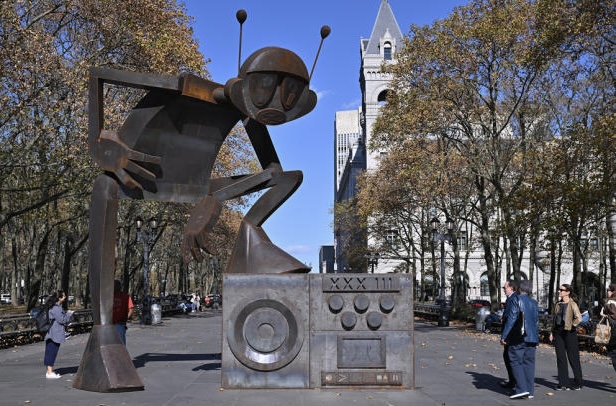A new sculpture has captured the attention of Brooklyn, standing tall and shining at 18 feet—a metallic homage to the quirky comic book character from the 1980s, “Max Robot”. The larger-than-life installation has taken over a busy Brooklyn neighborhood, sparking reactions from amusement to confusion as people stop in their tracks to marvel at its unconventional form. For some, the towering sculpture brings nostalgia for an offbeat comic character, while others are encountering Max Robot for the first time and struggling to make sense of the peculiar figure looming over the streets.
The artist behind this striking piece aimed not only to pay tribute to a niche cultural icon but also to engage viewers with the whimsical, imaginative spirit of the 1980s underground comic scene. And while interpretations range widely—from “weird” and “beautiful” to “thought it was a bug”—one thing is clear: “Rappin’ Max Robot” has made a memorable impression on Brooklyn.
For those who may not recognize the character, “Rappin’ Max Robot” was a fringe icon in the 1980s comic book world. Created as a humorous satire, Max Robot embodied the spirit of the era, blending elements of hip-hop culture with a futuristic, robotic twist. Max’s personality—a rhyming, rapping robot with a message—captured a generation’s fascination with technology, individuality, and rebellion. Through his rhymed verses and eclectic style, Max voiced the concerns and aspirations of a youth culture that felt disconnected from the mainstream.
The character of “Rappin’ Max Robot” served as both a parody and a tribute to early hip-hop culture, which was making waves in urban areas at the time. With his oversized sunglasses, boombox, and outlandish attitude, Max Robot embodied the creativity and individuality that defined both hip-hop and alternative comic culture in the 1980s. Today, while Max may not be as widely known, his unique charm and enduring appeal have made him a cult favorite—and a fitting subject for an attention-grabbing sculpture.
The sculpture itself is a towering, metallic construction of Max Robot, capturing the eccentricity and charm of the comic character while bringing him to life in an entirely new medium. Built with intricate metalwork, the 18-foot-tall statue captures Max’s iconic features: a blocky, angular body reminiscent of early robot designs, a large boombox that harkens back to his rapping roots, and, of course, his oversized sunglasses. Every detail is crafted to echo the original character while enhancing it for a new era, with a design that merges industrial aesthetic with a sense of playfulness.
Artist and sculptor Alex Gomez, who brought “Rappin’ Max Robot” to life in three-dimensional form, explained his vision for the piece: “Max has always represented this boundary-pushing, unapologetic creativity. With this sculpture, I wanted to capture that energy and make people look twice, maybe laugh or wonder what they’re looking at. He’s meant to be a little strange, a little out there—just like he was in the comics.”
The sculpture’s metallic sheen and towering size make it a focal point of the area, drawing the gaze of passersby who may not immediately recognize the character but are captivated nonetheless. Gomez’s design choices amplify Max’s otherworldly charm, making him seem both at home in the urban landscape of Brooklyn and slightly out of place, as if he’s just arrived from another dimension to entertain and bewilder his audience.
As is often the case with public art, the sculpture has elicited a wide array of responses. On social media and in local news, Brooklynites have shared their impressions, ranging from confusion to awe. “I thought it was a bug at first glance,” commented one passerby. The sculpture’s angular design and towering form do give it an almost insect-like appearance, especially from a distance. Its metallic surface and segmented limbs seem to morph in the light, causing the figure to resemble a robotic insect or alien to the uninitiated.
Others, however, have embraced the strangeness, finding beauty in the piece’s quirky character. “It’s weird but also kind of beautiful,” one local resident observed. The juxtaposition of the robot’s playful demeanor with its imposing height and industrial construction strikes a delicate balance, engaging viewers who might not immediately understand the reference but are drawn to its aesthetic. For long-time fans of Rappin’ Max Robot, seeing him reimagined as a public artwork is an exciting revival of a cult favorite that brings a touch of nostalgia to Brooklyn.
Impression
The sculpture’s appearance in Brooklyn isn’t just a tribute to a long-lost comic book character; it’s also a celebration of the cultural landscape that shaped Rappin’ Max Robot and the communities he represented. The 1980s marked a significant era for both hip-hop and independent comics, especially in urban centers like New York City. Rappin’ Max Robot was a product of this cross-cultural movement, with elements of hip-hop’s defiant spirit and comics’ experimental storytelling at its core.
By installing Max Robot in Brooklyn, the artist taps into the neighborhood’s historic connection to both hip-hop and street art, acknowledging the influence these movements had on each other. The larger-than-life statue is more than just an homage to a fictional character; it’s a celebration of an era when creativity, rebellion, and cultural expression flourished despite limited mainstream recognition. The statue serves as a reminder of Brooklyn’s role as a birthplace and incubator of these art forms.
One of the most striking elements of the “Rappin’ Max Robot” installation is its sheer scale and bold appearance, which challenge the traditional concept of public art. Unlike conventional sculptures or statues, which often blend into their surroundings or depict historic figures, Max Robot’s design is explicitly intended to disrupt the environment, drawing attention and sparking curiosity. This element of disruption is a critical part of the piece’s appeal, as it invites viewers to pause, ponder, and engage with the work in a way that conventional art might not.
Public art, especially of this scale and unconventional nature, has the power to reshape how people interact with their environment. By introducing a fictional, cartoonish figure into an everyday urban setting, the sculpture blurs the line between fantasy and reality. It encourages onlookers to question the purpose and meaning behind the installation, inspiring conversations that bring people together through shared curiosity. The act of stopping to look, wonder, and maybe even laugh creates a sense of community among those who encounter the piece.
The “Rappin’ Max Robot” sculpture has quickly become a point of conversation in Brooklyn, uniting locals and visitors through its audacious style and nostalgic charm. For fans of the 1980s comic, the sculpture is a long-awaited acknowledgment of a character who has often flown under the radar of mainstream pop culture. For newcomers, it’s a strange yet compelling sight—a blend of industrial design, pop culture, and humor that captures the eclectic spirit of Brooklyn itself.
Ultimately, the installation is more than a simple tribute; it’s a reminder of how art can bridge generations and cultures. By reviving Rappin’ Max Robot in such a bold, public format, the artist not only honors a niche icon but also invites a new generation to appreciate the character’s unique blend of hip-hop attitude, comic absurdity, and timeless creativity. As Brooklynites continue to “gawk” at this “weird and beautiful” figure, it’s clear that Rappin’ Max Robot has found a new life—and perhaps a new fanbase—in the heart of Brooklyn.
No comments yet.








